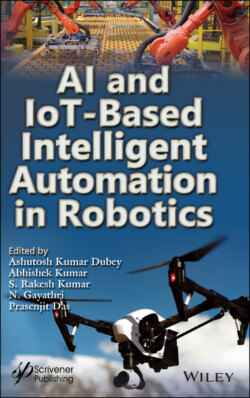Читать книгу AI and IoT-Based Intelligent Automation in Robotics - Группа авторов - Страница 2
Table of Contents
Оглавление1 Cover
2 Title Page
3 Copyright
4 Preface
5 1 Introduction to Robotics 1.1 Introduction 1.2 History and Evolution of Robots 1.3 Applications 1.4 Components Needed for a Robot 1.5 Robot Interaction and Navigation 1.6 Conclusion References
6 2 Techniques in Robotics for Automation Using AI and IoT 2.1 Introduction 2.2 Brief History of Robotics 2.3 Some General Terms 2.4 Requirements of AI and IoT for Robotic Automation 2.5 Role of AI and IoT in Robotics 2.6 Diagrammatic Representations of Some Robotic Systems 2.7 Algorithms Used in Robotics 2.8 Application of Robotics 2.9 Case Studies 2.10 Conclusion References
7 3 Robotics, AI and IoT in the Defense Sector 3.1 Introduction 3.2 How Robotics Plays an Important Role in the Defense Sector 3.3 Review of the World’s Current Robotics Capabilities in the Defense Sector 3.4 Application Areas of Robotics in Warfare 3.5 Conclusion 3.6 Future Work References
8 4 Robotics, AI and IoT in Medical and Healthcare Applications 4.1 Introduction 4.2 AI, Robotics and IoT: A Logical Combination 4.3 Essence of AI, IoT, and Robotics in Healthcare 4.4 Future Applications of Robotics, AI, and IoT 4.5 Conclusion References
9 5 Towards Analyzing Skill Transfer to Robots Based on Semantically Represented Activities of Humans 5.1 Introduction 5.2 Related Work 5.3 Overview of Proposed System 5.4 Results and Discussion 5.5 Conclusion References
10 6 Healthcare Robots Enabled with IoT and Artificial Intelligence for Elderly Patients 6.1 Introduction 6.2 Existing Robots in Healthcare 6.3 Challenges in Implementation and Providing Potential Solutions 6.4 Robotic Solutions for Problems Facing the Elderly in Society 6.5 Healthcare Management 6.6 Conclusion and Future Directions References
11 7 Robotics, AI, and the IoT in Defense Systems 7.1 AI in Defense 7.2 Overview of IoT in Defense Systems 7.3 Robotics in Defense 7.4 AI, Robotics, and IoT in Defense: A Logical Mix in Context 7.5 Conclusion References
12 8 Techniques of Robotics for Automation Using AI and the IoT 8.1 Introduction 8.2 Internet of Robotic Things Concept 8.3 Definitions of Commonly Used Terms 8.4 Procedures Used in Making a Robot 8.5 IoRT Technologies 8.6 Sensors and Actuators 8.7 Component Selection and Designing Parts 8.8 Process Automation 8.9 Robots and Robotic Automation 8.10 Architecture of the Internet of Robotic Things 8.11 Basic Abilities 8.12 More Elevated Level Capacities 8.13 Conclusion References
13 9 An Artificial Intelligence-Based Smart Task Responder: Android Robot for Human Instruction Using LSTM Technique 9.1 Introduction 9.2 Literature Review 9.3 Proposed System 9.4 Results and Discussion 9.5 Conclusion References
14 10 AI, IoT and Robotics in the Medical and Healthcare Field 10.1 Introduction 10.2 A Survey of Robots and AI Used in the Health Sector 10.3 Sociotechnical Considerations 10.4 Legal Considerations 10.5 Regulating Robotics, AI and IoT as Medical Devices 10.6 Conclusion References
15 11 Real-Time Mild and Moderate COVID-19 Human Body Temperature Detection Using Artificial Intelligence 11.1 Introduction 11.2 Contactless Temperature 11.3 Fever Detection Camera 11.4 Simulation and Analysis 11.5 Conclusion References
16 12 Drones in Smart Cities 12.1 Introduction 12.2 Utilization of UAVs for Wireless Network 12.3 Introduced Framework 12.4 UAV IoT Applications 12.5 Conclusion References
17 13 UAVs in Agriculture 13.1 Introduction 13.2 UAVs in Smart Farming and Take-Off Panel 13.3 Introduction to UGV Systems and Planning 13.4 UAV-Hyperspectral for Agriculture 13.5 UAV-Based Multisensors for Precision Agriculture 13.6 Automation in Agriculture 13.7 Conclusion References
18 14 Semi-Automated Parking System Using DSDV and RFID 14.1 Introduction 14.2 Ad Hoc Network 14.3 Radio Frequency Identification (RFID) 14.4 Problem Identification 14.5 Survey of the Literature 14.6 PANet Architecture 14.7 Conclusion References
19 15 Survey of Various Technologies Involved in Vehicle-to-Vehicle Communication 15.1 Introduction 15.2 Survey of the Literature 15.3 Brief Description of the Techniques 15.4 Various Technologies Involved in V2V Communication 15.5 Results and Analysis 15.6 Conclusion References
20 16 Smart Wheelchair 16.1 Background 16.2 System Overview 16.3 Health-Monitoring System Using IoT 16.4 Driver Circuit of Wheelchair Interfaced with Amazon Alexa 16.5 MATLAB Simulations 16.6 Conclusion 16.7 Future Work Acknowledgment References
21 17 Defaulter List Using Facial Recognition 17.1 Introduction 17.2 System Analysis 17.3 Implementation 17.4 Inputs and Outputs 17.5 Conclusion References
22 18 Visitor/Intruder Monitoring System Using Machine Learning18.1 Introduction18.2 Machine Learning18.3 System Design18.4 Haar-Cascade Classifier Algorithm18.5 Components18.6 Experimental Results18.7 ConclusionAcknowledgmentReferences
23 19 Comparison of Machine Learning Algorithms for Air Pollution Monitoring System 19.1 Introduction 19.2 System Design 19.3 Model Description and Architecture 19.4 Dataset 19.5 Models 19.6 Line of Best Fit for the Dataset 19.7 Feature Importance 19.8 Comparisons 19.9 Results 19.10 Conclusion References
24 20 A Novel Approach Towards Audio Watermarking Using FFT and CORDIC-Based QR Decomposition 20.1 Introduction and Related Work 20.2 Proposed Methodology 20.3 Algorithm Design 20.4 Experiment Results 20.5 Conclusion References
25 21 Performance of DC-Biased Optical Orthogonal Frequency Division Multiplexing in Visible Light Communication 21.1 Introduction 21.2 System Model 21.3 Proposed Method 21.4 Results and Discussion 21.5 Conclusion References
26 22 Microcontroller-Based Variable Rate Syringe Pump for Microfluidic Application 22.1 Introduction 22.2 Related Work 22.3 Methodology 22.4 Result 22.5 Inference 22.6 Conclusion and Future Works References
27 23 Analysis of Emotion in Speech Signal Processing and Rejection of Noise Using HMM 23.1 Introduction 23.2 Existing Method 23.3 Proposed Method 23.4 Conclusion References
28 24 Securing Cloud Data by Using Blend Cryptography with AWS Services 24.1 Introduction 24.2 Background 24.3 Proposed Technique 24.4 Results 24.5 Conclusion References
29 Index
30 End User License Agreement
